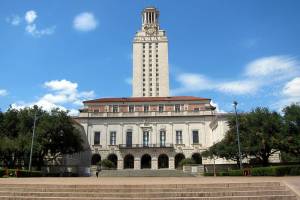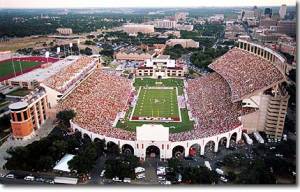You might think that since I graduated from the University of Texas, lived in proximity to its campus for more than three decades and wrote four books about it, I would be among the most gung-ho of Longhorns. Before stating why that is not exactly the case, I will confess to being a proud alumnus. When I got a letter of admission from UT during my senior year of high school, it was a happy day indeed.
A fine education if you want it
Long recognized as the flagship university of the state of Texas (sorry, Aggies!), it is not Harvard, and it’s not Yale or Stanford or Duke or any of those high-priced private schools. Nevertheless, it’s one of the top  state-supported American universities. US News & World Report’s 2014 rankings has UT as the 52nd best college in the country. You can get a fine education there, although that is just my general impression. The place has changed drastically from my student days; I was an undergraduate in the early and mid-1970s, some forty years ago. UT today is much harder to get into than it was when I matriculated. In fact, I almost certainly could not gain admission now. It is also far more expensive, as tuition and fees are about $10,000 per year. When I was there, $1,500 was sufficient for that, plus room and board, books, everything.
state-supported American universities. US News & World Report’s 2014 rankings has UT as the 52nd best college in the country. You can get a fine education there, although that is just my general impression. The place has changed drastically from my student days; I was an undergraduate in the early and mid-1970s, some forty years ago. UT today is much harder to get into than it was when I matriculated. In fact, I almost certainly could not gain admission now. It is also far more expensive, as tuition and fees are about $10,000 per year. When I was there, $1,500 was sufficient for that, plus room and board, books, everything.
Now, the truth. I have been ambivalent about UT beginning with my first day in Austin. It was so big—around 40,000 students then—that I felt overwhelmed. The “face-in-the-crowd” phenomenon really affected me, as it did many other freshmen, sophomores, and so on. I remember with no fondness sitting in an auditorium with 350 other students, listening to a professor who stood on a stage with a microphone in hand. There were several such classes. I should have been well prepared for life on the 40 Acres since I came from a very large (3,300 students) high school in a big city (Dallas). What was it like for kids who had been raised in rural parts of Texas?
Back then, I had serious self-doubts. To paraphrase a character from Saturday Night Live, Was I good enough? Was I smart enough? Did people really like me? There was so much happening on that campus, I scarcely knew where I fit in. I regret that I did not find a couple of clubs or activities in which to participate and have a stronger sense of belonging. Besides taking care of my academics, I did little beyond play handball and basketball at Gregory Gym, and attend movies with my girlfriend. I failed to  find a professor who could serve as a mentor. Neither of my parents had graduated from college and could motivate or give guidance.
find a professor who could serve as a mentor. Neither of my parents had graduated from college and could motivate or give guidance.
In dire need of direction
Lacking direction when I was at UT, I had no idea what I planned to do with my life and what the options were. These insecurities should not be blamed on the university, big and impersonal though it may have been. Of course, I do not mean to characterize myself then as a helpless waif. I coped better than some. I recall the students who jumped off the UT Tower or, less dramatically, dropped out. My roommate at Jester Center during my freshman year was Mike McBryar of Dickinson, Texas. Compared to him, I was a smashing success. Mike seldom went to class and was even afraid to visit the Jester cafeteria. He was soon gone.
I muddled through, taking history courses because I knew I could pass them. Garrison Hall, then home to the UT history department, was my favorite building on campus. My grades, which hovered between B’s and C’s, were nothing special. But again—far better than my old roomie. By my junior year, I realized I was getting a basic, liberal arts education. I marveled at those students who had clear goals, knew how to achieve them and worked furiously in the process. I was not like that. Still, I refused to think of myself  as a failure because, in fact, a great many other students at the university were in the same boat. In 1973 and 1974, I had one thing in mind: get that degree. I may not have been a superior student, and my post-graduation days seemed murky, but I figured I could handle that.
as a failure because, in fact, a great many other students at the university were in the same boat. In 1973 and 1974, I had one thing in mind: get that degree. I may not have been a superior student, and my post-graduation days seemed murky, but I figured I could handle that.
Now I look at the gold, somewhat battered class-of-1976 ring I bought at the University Co-op on the Drag or the diploma handed to me during graduation ceremonies in May of that year. I cannot say I recall my college days with great passion. As mentioned before, “ambivalence” is the key word. The fact that I stayed in Austin for so many years after graduating indicates a connection of some kind. I grew up and learned to think critically and independently, for which I remain grateful.
Go orange, go white
I am not averse to wearing orange and white—there are three UT T-shirts, two UT baseball caps, two UT football jerseys and a UT basketball jersey in my closet here in Seoul. But having lived sixty-plus years has given me perspective. I realize that my alma mater is not unique. What if I had been born and raised in Cincinnati? I probably would have attended Ohio State and had much the same experience. If I were a native of Portland, I would have gone to Oregon. Were I from Charlotte, I would have undoubtedly been a UNC student. By the way, I have been to those campuses in Columbus, Eugene and Chapel Hill. There is little difference between them and Austin. So forgive me if I do not get emotional when I see a photograph of Bevo or when “The Eyes of Texas” is played.


Add Comment